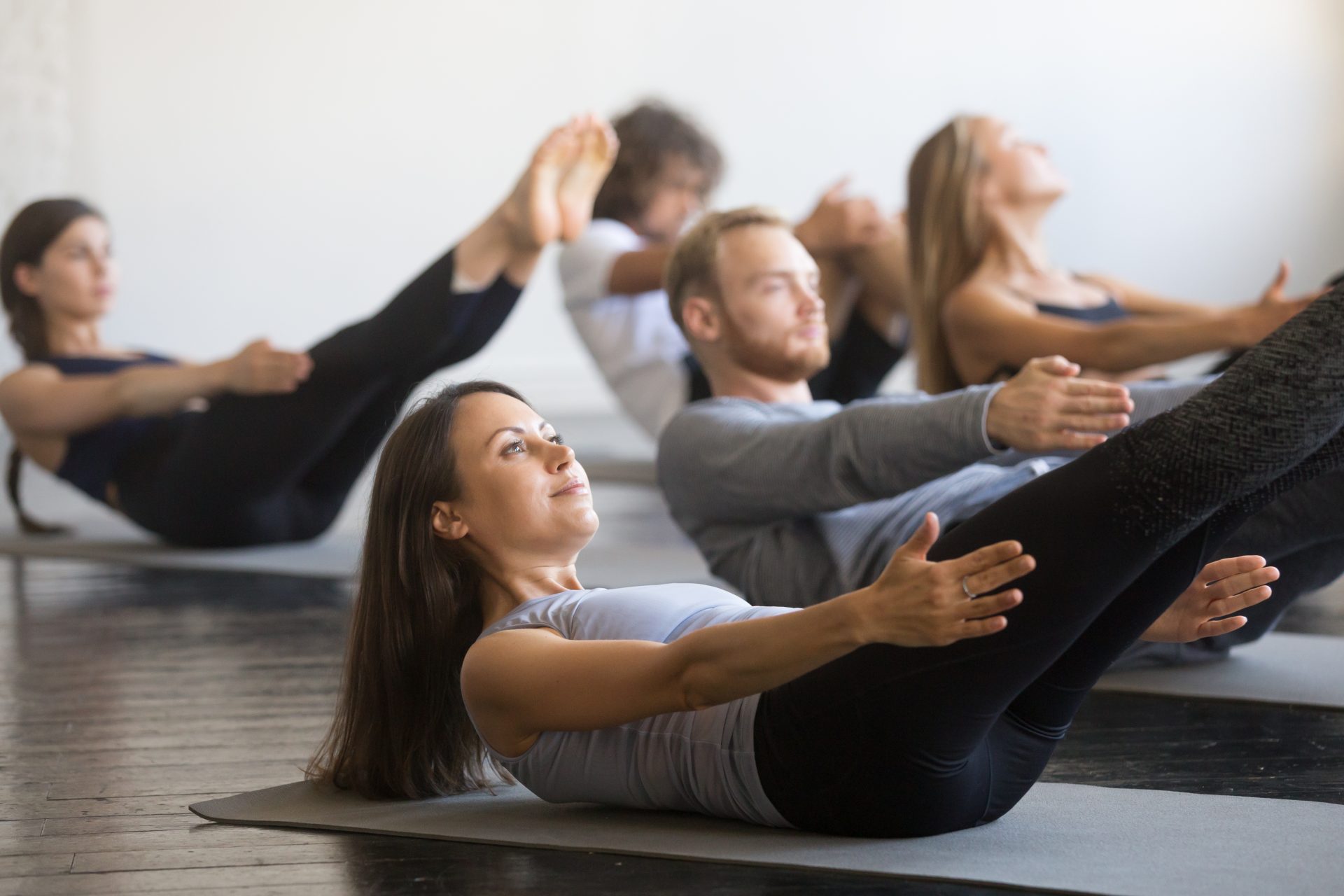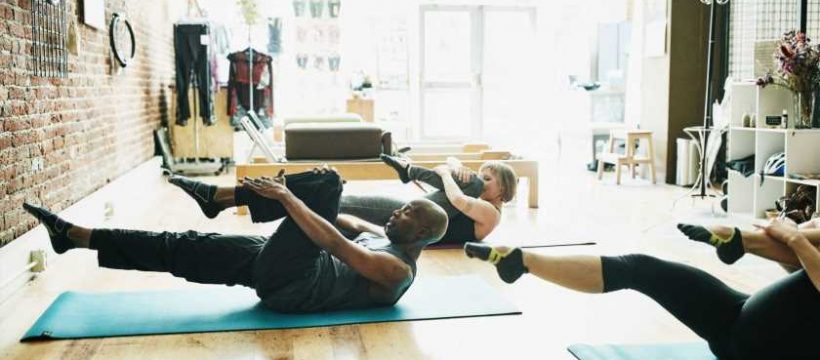You might assume that a 45-minute pilates class is a relaxed workout option but you’d be wrong. There’s a reason that so many people swear by pilates – mat or reformer – and it’s largely to do with the burn.
Some days you just don’t feel like smashing the weights room or struggling through the kilometres on a run but you still want to do a workout. Yoga? Bit too passive. Swimming? Too much admin. Walking? Not muscle-hitting enough. It’s then that pilates might swing into view. It’s low-impact, core-hitting, balance-promoting and you can do it at home, at the gym or in a fancy studio. Perfect.
Perfect, that is, until you find yourself halfway through a set of 100s (a classic exercise that demands you balance on your coccyx as you frantically wave your hands up and down) and your core muscles start to feel like they might burst open. You’ve got beads of sweat dripping down your face and between your boobs. Your deepest core is shaking like a jelly. And you’ve still got a whole minute left to go.
Pilates is bloody hard, and what’s more, it’s bloody painful. I’ve run umpteen marathons and yet, a 45-minute pilates class still feels like torture. Reformer pilates is slightly less unpleasant than mat-based classes (at least there are a few exercises that allow you to use bigger muscles like the hamstrings and shoulders), but the moment that awful ring comes out, you know it’s game over for the inner thighs.
You may also like
Pilates training: “this is how 5 minutes of pilates every day for 2 weeks changed my body”
While the shake is real, pilates is so good for us. I’d never normally advocate doing things that you know will cause you pain, but there’s a reason that pilates hits us where it hurts. For a start, it’s a workout designed to hit those small, harder-to-reach muscles that can help us to balance better, move freer and lift heavier.
“We want every muscle in the body to be strong and functional – there is no ‘king’ group of muscles here,” explains Hollie Grant, founder of Pilates PT. It’s this that sets pilates apart from other forms of training: “There’s no emphasis on weight loss, aesthetics or area-specific training. Pilates is about seeing the body as a whole and making it as functional as possible. It’s also quite clinical and instructors are usually very highly trained. Their understanding of anatomy and how the body functions is a huge part of their skillset.”
The burn you feel in the 100s, Grant goes on, “is actually a build-up of lactic acid in the muscles being used (which is a positive effect) and exercises that promote endurance, such as the 100s, will often create this feeling due to the repetitive nature of the exercise.” Those endurance exercises are important, she says, especially when they involve postural muscles that play a big role in day-to-day functioning. “We don’t just want strong muscles; we want muscles that can handle 24/7 life.”
And that’s more or less what pilates is all about. When we lift weights, we’re working specific muscles to build overall strength – but it’s relatively rare to do a session that involves doing 20 reps or more. We almost exclusively work for hypertrophy or power – short, sharp bursts of effort for maximum gains.
The stronger you get, the easier it is to deadlift 50kg, for example, and you can move up a weight or two. In pilates, however, “we combine endurance exercises with power and strength exercises […] meaning that, in theory, that burn will never disappear, as your effort levels simply increase as you get stronger,” says Grant. “It’s a positive sign, even if it makes you squirm.”

Paola Langella is a pilates instructor and the founder of Shapes Studio, and she agrees with Grant that exercises like the 100s never really get easier – even after years of practising. “That’s because the more experienced you are, the better you can connect and become more flexible in your spine, meaning you’re better able to engage your abs. The better you get, the more you’ll also be able to challenge yourself, using props like a ring between the legs, or light weights for the arms. There are many 100s variations that can challenge etoiles and athletes.”
Breathwork is an essential part of pilates for injury prevention and core activation
Langella explains that the added concentration on breathwork is what makes pilates such an effective workout. “The diaphragmatic breathing compared to the belly breathing helps to engage the deeper layer of our abdominals (transverse abdominals) that wraps around our back like a corset, and keeps us safe and strong during exercising,” she tells Stylist. For Langella, pilates is all about controlling the body and upholding the quality of movement. You get a sense of that at most classes, where instructors continually remind pupils to keep a neutral or flat back during certain exercises.
That’s all part of the plan, Langella says: “This way, we’re able to prevent ourselves from injury, but also we feel every single exercise in a more effective way: just a few reps results in a strong burn. You can really target the right muscles and feel and see the results after just five sessions.”
So, given how painful it can be, does that mean that the whole ‘no pain, no gain’ mentality has a place in pilates? “I always say to my clients, ‘If it’s easy, it’s not pilates’,” says Langella. “In pilates, you’ll always feel ‘the pain’, but there’s a chance that you might not experience sore muscles the day after. The goal should be to leave the class feeling balanced, resorted and feeling lighter.”
Pilates: no pain, no gain?
Grant agrees that there’ll always be exercises you really ‘feel’ but not all pilates exercises need be that intense. “Some pilates exercises such as the saw might not burn but are still important. We have different purposes for different exercises, and they won’t all feel intense, but that doesn’t mean they should be avoided.
“‘No pain, no gain’ isn’t strictly true, but it’s a fact that when certain exercises burn, it’s an indication that you’re doing them correctly.”
If there’s one thing you need to be prepared for, it’s this: pilates isn’t easy. Grant says that she often gets clients who seem surprised at how challenging a class can be, but flags that it’s important to remember the purpose of pilates: to look for weaknesses and to fix them. “I’ve trained professional rugby players and professional ballerinas and made them tremble. I’ve trained my husband and made him tremble. Pilates teachers will always find something to work on, so for that reason it should never be easy – but it works!”
Images: Getty
Source: Read Full Article
